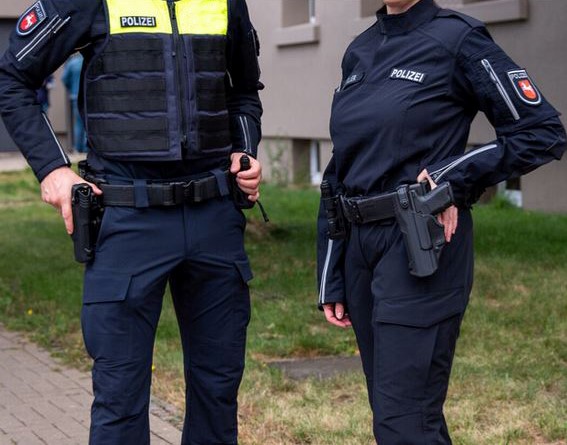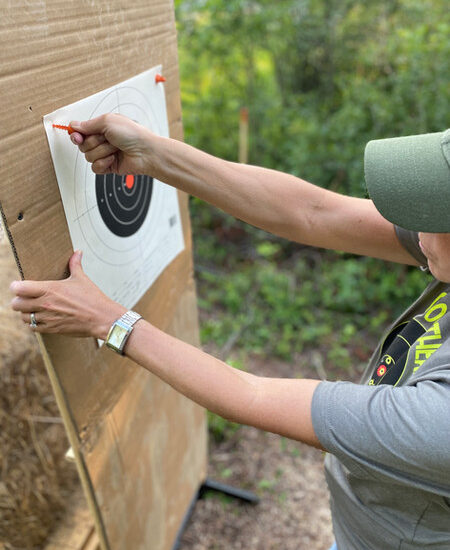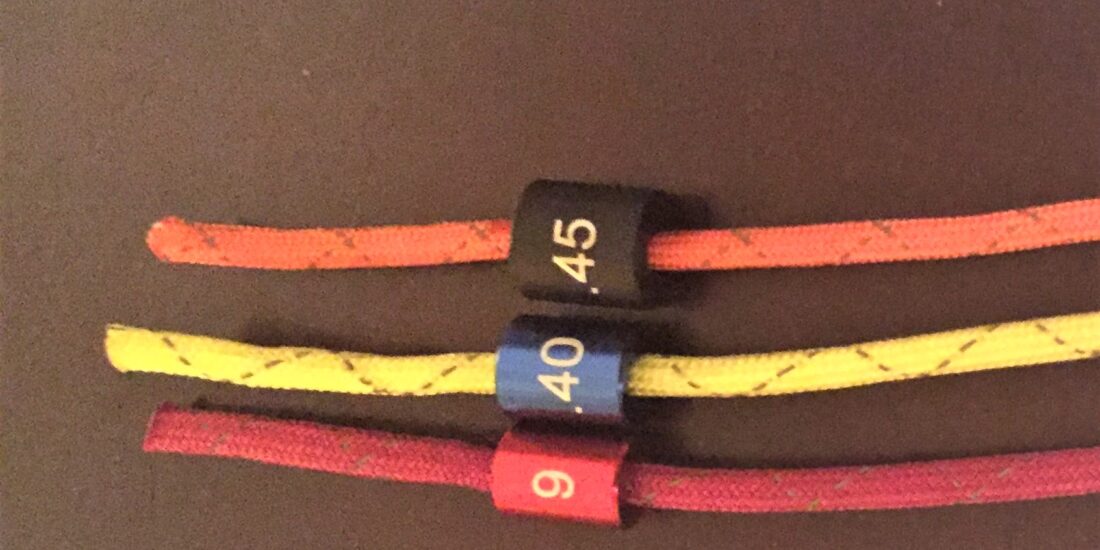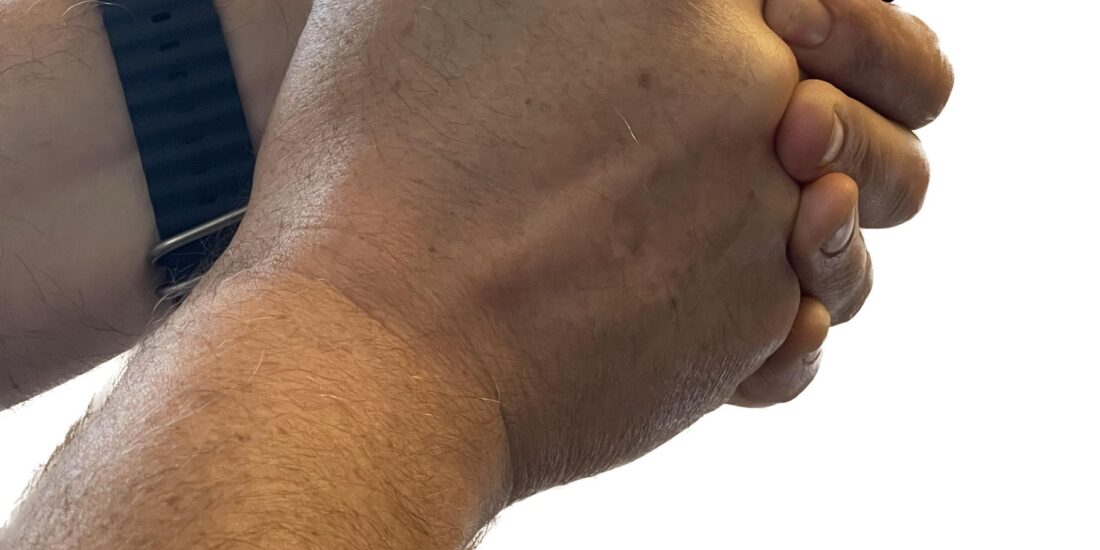Handling Stress In Shooting (Qualifiers, Competition, Defense)

I recently taught a class called “Qual Like A Boss” 🙂 at the A Girl and A Gun National Conference and it was an AWESOME class to teach.
I was fortunate to learn a lot of lessons on how to perform at a high level under stress early on, but then I discarded them, thinking they were too simple to work.
The fact is, a lot of times, the simplest solutions are the right solutions.
There are some nuggets here that will be applicable to everyone and applicable to WAY more of your life than just shooting.
Please understand that I’m faced with the challenge of trying to summarize a 4-hour live presentation into an article that can be read in a few minutes on a phone.
That means I need to skim over a lot of detail, but I will link to where you can dig in and get all of the detail you need. If there’s enough demand, I’ll do a live, online version of the training.
To begin with, the qualifier in particular that they were focused on was the FBI Instructor Qualifier.
This is a 50 round qualifier with strings of fire shot between 3 yards and 25 yards.
I knew I was going to have a half-day with them, but that’s not really enough time to create long term change in their SKILL level…I may be able to create in-the-moment change and give them a glimpse of what they could do if they trained on their own, but I wouldn’t be able to change skill in a way that would last long term in that short of time.
So, I decided to focus purely on performing under stress and vision, balance, and body awareness.
The cool thing is, in any physical skill, roughly 90% of how we perform under stress is a matter of our ability to manage stress and our ability to quickly and accurately sense where we are in relation to the world around us (vision, balance, body awareness.) If I could help them with 90% of the performance equation, they could figure out any gaps in their skill once they got back home.
I started out by recording a guided relaxation and visualization script for them to listen to for a week or two before the class.
I was fortunate in the late 80s to get to go to resident track & field camp at the University of Nebraska in the summers. The 88 Olympics had just happened and we had Olympic coaches and performance psychologists as well as UNL coaches working with us.
One of the things that they taught us was how to visualize. In the 34 years since, I’ve only run into a couple of people who teach how to do it correctly…the most notable being Matt & Sherrie Seibert of Insight Firearms Training in Prescott Valley AZ.
Every other article, speaker, and video I’ve seen/heard since teaches a watered down, relatively ineffective method of visualization. They do the visualization in the wrong brainwave state and focus on the wrong things. In a lot of cases, visualization methods are taught that actually increase the chances of random performance rather than predictable success.
So, on the audio track, I started with some breathing exercises and isometric tension and then took them through a guided process of relaxing their entire body.
Once they were relaxed and focused, I started going through the qualifier…shot by shot, explaining what they should be thinking and focusing on with each shot.
This is SUPER important. There are a few classes of things that we can be thinking about, and for each one, focusing on the right one makes a HUGE difference between predictable success or random performance.
Past vs. Present vs. Future Focus: Past results should have NO emotional impact on current performance, unless you let it. For distance shooting and shooting moving targets, a past miss may drive a correction in where you aim, but it should not change what you feel. In training you want to celebrate wins, but when you’re performing, you really don’t want to care any more than you need to to be at an optimal level of excitement.
Future results that haven’t happened yet aren’t worth thinking about. The most likely result is going to be that a loss of focus on the present causes you to perform worse. The time for planning your stage and thinking through what you’re going to do is BEFORE the event, in training…not while you’re performing.
And, if you find that you need to plan something out on the fly, you want to do it before or after the actual moments of shooting…not while you’re pressing the trigger.
You want to focus on the present. That is where all of the action is. That is what you have the most ability to influence. Not to go too far down the rabbit hole, but the .10 seconds – .25 seconds before you take action, you want to be 100% in the moment.
Internal vs. External Focus: To the extent that you can, you want to get out of your head and focus on external things. In the movie Decoding Greatness, Jerry Rice talks about how when they were in a critical situation and the opposite team would call a timeout, he would turn off inner-dialog, find someone in the audience, and burn a hole through them with his stare. 100% of his focus was on them…not on internal chit-chat. For shooting, that can be your target, front sight, dot, reticle, etc.
Wide vs. Narrow Focus: Situational awareness is awesome, but in the .10-.25 before we press the trigger, our whole world should either be the front sight, the dot, or where we want the hole. Before that, wide vision is great. After that, wide vision is great. But, in the moment of performance, narrow focus is key. This was proven out by Dr. Joan Vickers in the early 80s as a key difference between experts and novices and re-proven in study after study over the last 40 years.
Outcome vs. Process Focus. This is similar to time focus, but enough different to split out. We shouldn’t care about what happens on the paper. Only the defined process that will get us the results we need. We don’t control the outcome, but we absolutely control the process. Furthermore, if we don’t know the process that gets us positive outcomes, we’re more likely to have random performance.
There were several cues in the visualization to help the shooters break down the qualifier and be comfortable with it.
When to calm down, when to take a moment, smile, and relax, quick things to do to bleed off stress if necessary, and cues to focus on while performing.
The audio track is available in the members’ area for Upgraded Shooter. If you’re not a member…you absolutely should be and can sign up >HERE<
I’ll tell you what I told them in class about the audio track.
I do this guided relaxation process almost every night going to sleep in my head, without a recording. I just use my own voice in my own head.
I encouraged them to use the recording as a guide, but to make it their own as soon as possible after the class and try to get to where they can talk themselves through it on their own without needing to listen to anything.
The next thing I did was give them a written shot-by-shot and skill-by-skill breakdown of the qualifier.
This is important.
The FBI qualifier tests several skills, and, unless it’s already easy for you, you want to break it down into it’s individual components, work on them, and then piece them together once you can do them in isolation.
As an example, string 1 is to draw, fire 3 rounds, switch hands, fire 3 rounds in 6 seconds.
I broke it down for them…
Draw and fire 1 shot in 2 seconds.
Fire the next 2 shots with .40 splits
Transition to support hand and shoot 1 shot in 2 seconds
Shoot 2 more shots with .60 splits.
So, instead of 1 string of fire, they now had 4 distinct things to practice…2 of which they could measure and improve with dry fire with a high level of skill transfer to live fire.
All of a sudden, the qualifier didn’t seem like eating an elephant in 1 bite. They had a plan to eat it bite by bite over time.
Next, we went through neurological drills that they could do to calm their limbic system and help them shift from being in a sympathetic state to being in more of a parasympathetic state.
We discussed cupping the eyes and square breathing (see https://AutomaticAiming.com)
We worked on manipulating physiology by changing the ratio of time that they inhaled vs. exhaled as well as which nostril they breathed through.
We looked how to use eye position to quickly melt stress and drive a calmer state of mind. We cover this in the Praxis Group Coaching.
One of the big ah-ha moments was the visualization of a “threat bucket” in the brain where everything that the brain sees as a threat gets put.
As the level goes up, we experience more stress and eventually, it becomes enough that it’s like a circuit breaker breaks. The brain cries “Uncle!” and we experience less range of motion, less strength, less speed, and more pain.
Some of the things that go into the threat bucket are environmental factors, like heat/humidity/wind (we were getting temperatures between the 40s and 80s and up to 40mph gusts in a desert environment.) Also relationships, financial concerns, ego, illness, fatigue, dehydration, hunger, eating food that your body doesn’t like, joint pain, past injuries, inflammation, low blood sugar, low oxygen, balance challenges, visual challenges, and more.
The crazy thing about humans is that if we feel stressed and can’t figure out WHY we’re stressed, sometimes we feel MORE stress. But if we can identify why we feel stressed, oftentimes that simple realization is enough to allow us to be less stressed.
Oftentimes, we feel stress because a particular part of the brain isn’t getting enough oxygen and glucose. This is particularly the case with the senses…vision, balance, and body awareness.
We may not realize it until we get restricted range of motion, stiffness, or pain.
In a lot of cases, these patterns can go on for months or years.
So, I did a few neuro drills to increase blood flow (oxygen and glucose) to key parts of the brain that proved to be very helpful.
I asked if anyone had a stiff neck and several hands went up…this is common. I had them do a drill with their ear that I cover in Praxis Group Coaching and most of them had an immediate reduction in stiffness and an increase in pain-free neck range of motion. For some, there was an immediate calming effect as YEARS of tightness melted away in seconds.
One of the key requirements for fast, accurate, multi-shot strings of fire is grip strength and it’s physiologically normal for women to have less grip strength than men, so any gains that we can get are simply incredible.
Many guys talk about how easy the FBI qualification is, but for a woman without the necessary grip strength to manage recoil in a timely manner, it can be quite a challenge.
Now, when I’ve got students in a class with me, telling them to go do grip exercises won’t do a darn bit of good for the time that they’re in front of me. So, over the years, I’ve had to figure out methods of increasing grip strength in students in 1-2 minutes so that they can shoot better IMMEDIATELY…not after they’ve used a grip trainer for 6 weeks.
So, I ran the class through a few of these drills. Normally, the average improvement is in the 10-20% range, and 50% is about the max…but one of the ladies who had rheumatoid arthritis had a 60%! increase in grip strength after doing a 1 minute drill. We cover these in the Praxis Group Coaching as well, and I may do an online instructor training where I go over several techniques like this if there’s enough demand.
How big of a deal was this?
It takes roughly 60 pounds of grip strength as measured on a grip dynamometer to shoot accurate .25 splits with a Glock 26 with an extended mag and a 2-handed grip. < LOTS of variables there and those numbers are an over-simplified conceptual guide.
Her initial grip strength was 32 pounds. That would make it very, very difficult, if not impossible, to shoot fast and accurately enough to pass the qualification.
After a 1 minute drill, she was at 54 pounds and suddenly she was within striking distance. That’s huge.
Another common pain point for shooters is tight hip flexors.
So, I had the shooters with tight hip flexors test their flexibility, and then do a 1 minute drill that takes advantage of inter-limb neural coupling and several of them, again, had a big jump in flexibility and an increase in calmness and a reduction in perceived stress level.
Next, we did the same thing with tight/stiff lower backs. We got the same increase in calmness and reduction in perceived stress level.
And, eventually, we started doing some work with guns. 🙂
For the shooting, we were doing laser dry fire, but it’s hard to time people shooting a laser gun with no recoil. So I used a vibration activated, rail mounted laser on a T4E CO2 .43 paintball marking pistol. They could see where they were hitting because of the laser and the recoil was enough to activate my ShotMaxx shot timer.
We mainly worked on both eyes open shooting and eyes shut shooting and did some of the drills from the Automatic Aiming presentation that allowed them to aim better with their presentation and have less visual confusion with both eyes open.
Again, this was a 4-hour live presentation…WAY too much detail for an article that 40% of my readers will read on a phone a few minutes at a time. But, if you want to learn more about this, you have a couple of options…
I cover stress modulation, and the FBI Instructor Qualification relaxation and visualization in Upgraded Shooter, Praxis Dynamic Gunfight Training, and Praxis Group Coaching (Only available to Praxis students, but if you want to sign up for both at the same time, let me know by commenting below).
I cover stationary vision, balance and body awareness in See Quicker Shoot Quicker, and dynamic vision, balance, and body awareness in Automatic Aiming and Praxis.
Eye dominance and visual confusion? I cover that in Automatic Aiming.
Interested in a training package that includes both Praxis and a T4E CO2 training pistol with 3x the recoil of airsoft at a HUGE savings? Then check out this offer >HERE<
And, want me to come to where you live and cover all of it with you and your group? Let me know and I’ll fill you in on the details.






